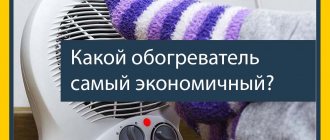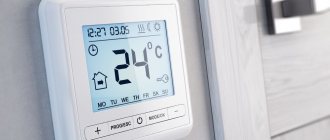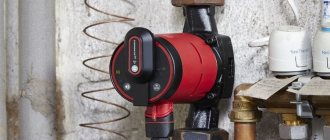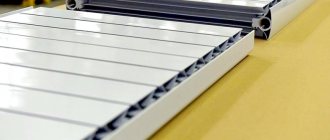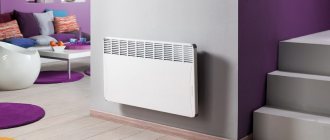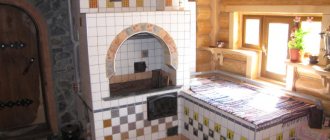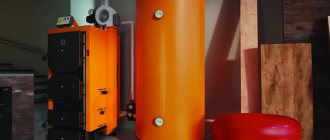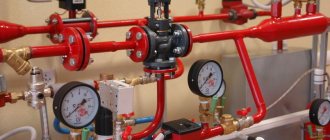Electric heaters of the new generation are economical and are one of the best options for heating a private home today. Let's look at what types of modern electric heating devices that economically consume electricity for residential premises exist, what are their differences and what are the main features, by what criteria should they be selected, and how to correctly calculate their power for specific application conditions.
Infrared heater in the house on the wall Source ali-top.ru
Introduction
With the onset of golden autumn, when utility workers have not yet woken up, the temperature in our apartments sometimes drops to indecent levels.
In such an extremely unpleasant situation, it is necessary to act somehow. Which home heater is the most economical and inexpensive? But what to do if electricity bills are getting higher every year, as are prices in stores, how can you escape from this terrible cold? The only option left is to choose the most economical, inexpensive, efficient heater with the highest efficiency, and we will try to help you in this matter.
Types of heaters
Today on the market there are a great variety of different electric heating systems, from simple small heaters to complex systems of heated floors, walls or ceilings with remote control coupled with smart home systems, but all of them can be divided into just a few types:
- Electric (fan heaters)
- Electric fireplaces
- Oil radiators
- Convectors or convection heaters
- Quartz panels
- Infrared. They differ by type of heating element: halogen, carbon, quartz, micathermic (best efficiency)
Ceramic panels
The operating principle of the ceramic panel is based on long-wave infrared radiation. The heating panel is enclosed in a steel box, characterized by high thermal conductivity and energy saving. Thanks to its neutral appearance, ceramic hobs will fit into any interior.
The energy consumption of a panel is directly proportional to its size. On average, it ranges from 0.2 to 2.5 kW/hour. To heat a room of 20 m², 1 kW/hour is required. It will take 1.5-2 hours to fully heat the room.
Micathermic heaters are a new product on the heating equipment market.
Principle of operation
First, you need to remember the principle of operation of heaters. Fan heaters are considered the simplest devices; heating occurs due to the distribution of hot air by a fan through an incandescent lamp; the efficiency is quite low.
The principle of electric fireplaces is similar to fan heaters; as a rule, such devices are stationary and have rather a decorative component; the efficiency of such devices is at an average level.
In oil radiators, heat is distributed by heating the oil inside the heater using heating elements. Heating takes quite a long time, but cooling is noticeably slower. Due to the smooth heating of the oil inside the radiator grille, such batteries cannot be called economical, and later you will find out why, the efficiency is low. Even in some European countries they are assigned class C for energy efficiency.
Convectors operate on the principle of convection by circulating air inside the room through the heater. Heavy cold air falls down, is captured by the convector, heats up and rises, and as it rises it displaces the cold air. The efficiency of such devices is quite high.
Quartz panels are an electric heating element enclosed between artificial stone panels; the efficiency is average. First, energy is expended on heating the plates and further slow heat transfer occurs from these plates.
Infrared heaters are equipped with special emitters (lamps) that emit infrared rays that are invisible to humans and primarily heat the surrounding objects, rather than the air around them. They differ in the type of lamp emitters : halogen, carbon, quartz. Such devices are more economical than oil and electric fireplaces. The efficiency is quite high, see table below.
Infrared with micathermic heating elements have appeared quite recently. This is an innovative type of infrared heaters with the highest efficiency. Unlike conventional infrared heaters, in such heaters the source of thermal energy is a special design made of Micatherm panels, which distributes invisible, safe infrared radiation. As a result of exposure to such radiation, surrounding objects, rather than the environment, heat up.
Convective
The operating principle of convective heaters is based on air movement: cold air enters the fan, the heating element converts it into warm air, after which the heated air comes out and rushes upward. Thus, the air constantly circulates throughout the room, providing uniform heating. The room warms up quickly and efficiently.
Convectors are economical, and simple models are budget-friendly, however, their fire hazard is quite high. Those equipped with a complex system of emergency shutdown, safety and protection are more expensive, while all of them dry out the air during operation. It makes sense to buy a convective floor or wall-mounted economical electric heater for your dacha if you do not live there permanently and there is no need to install a heating system.
Electric convectors can quickly and efficiently warm up a room.
Efficiency of the main types of home heaters
Everyone knows what efficiency is, this is the difference between the energy expended and the energy produced. When calculating the coefficient, we tried to provide the most detailed answer in tabular form . Since, in addition to the energy component, there are also financial costs for the purchase of the device itself, electricity costs, the calculation is made taking into account these factors.
The table shows the average values obtained from tests of various types of heaters (thanks to one well-known store for providing testing equipment). The cost for 1 kW of energy is 4 rubles. Heating took place for 1 hour in a furnished room of 18 square meters with an initial temperature of 22 degrees C. Heater power 1500 W. Control type – electronic.
| View | Average price, r | Declared maximum power, W | Temperature change over 1 hour, gr. WITH | KW consumed according to the meter | Cost of consumed electricity, p |
| Fan heater | 1250 | 1500 | +3,9 | 1,69 | 6,76 |
| Oil | 3200 | 1500 | +5,1 | 1,74 | 6,96 |
| Convector | 3540 | 1500 | +6,2 | 1,52 | 6,08 |
| Infrared | 3580 | 1500 | +6,1 | 1,22 | 4,88 |
| Micathermic | 7800 | 1500 | +7,0 | 1,24 | 4,96 |
The obtained figures are approximate, since many important factors influencing the result are not taken into account, such as: a single brand of the manufacturer, humidity in the room, the model of the heater itself, direction, voltage in the electrical circuit, etc.
But nevertheless, the figures turned out to be the following; the highest efficiency was obtained from convectors, infrared, and micathermic heaters. The fan heater was barely able to heat the room by 4 degrees.
The oil radiator heated the room quite well; after the end of the experiment, the room continued to heat up and remained heated longer than others, so it should not be written off due to high power consumption.
In addition to the electronic type of control, there are also mechanical (outdated) and inverter (the most modern and economical). If we compare the electricity consumption of similar heaters with different control modules, the following figures come out:
mechanical - 0% savings, the electronic unit allows you to save 30% in contrast to the mechanical one, the inverter control unit is the most economical, this method of thermoregulation allows you to save up to 80% of electricity compared to mechanical regulators.
Inverter thermostat
The cost of heaters with inverter units can vary from 8,000 to 30,000 rubles. In the long term, as a rule, such costs pay off. More details in the video:
Why some heaters are more economical than others, pros and cons
The fact is that different heaters use different methods of heating the room, some use heating elements, others use infrared radiation and oil coolants.
The primary most important factor influencing savings is the correct selection of a heater of the required power for a given room area. For example, if you try to heat 400 m2 with a fan heater for 900 rubles, you may not only not heat anything, but also get a good electricity bill at the end of the month , see the table below .
| Room area, sq.m | Power (Watts, W) |
| 5,0-6,0 | 500-750 |
| 7,0-9,0 | 750-1000 |
| 10,0-12,0 | 1000-1250 |
| 12,0-15,0 | 1250-1500 |
| 15,0-18,0 | 1500-1750 |
| 18,0-25,0 | 1750-2000 |
| 25,0-30,0 | 2000-2500 |
| 30,0-35,0 | 2500-2900 |
Important! If you choose a heater as a non-main source of heat, for example, for the spring-autumn period. One order of magnitude less choice is enough For example, 30sq.m-2000W . Another situation is if the main heating source is not enough for you, for this you need to make simple calculations and acquire a suitable energy-saving heater designed for a smaller area.
Also , do not forget that not all heating systems distribute heat evenly around themselves, there are directional, all-round, there are floor, wall, ceiling, they all have their pros and cons. Let's look at the advantages and disadvantages of the most popular ones:
Fan heaters
- pros
Mobility, democracy, fairly quick heating of the room
- minuses
Noisy, dry the air, raise dust, burn oxygen, cannot be left unattended, average efficiency
Oily
- pros
Slow cooling, silent operation, thermostat, overheating protection
- minuses
Slow heating, low efficiency, body heating
Convectors
- pros
Silence, safe heating of the case, thermostat, high efficiency
- minuses
They dry out the air, burn out oxygen, and become clogged with dust.
Infrared
- pros
Quiet, economical, do not dry out or burn oxygen, fast heating
- minuses
Expensive
Micathermic
- pros
High efficiency, maintaining a uniform microclimate
- minuses
Increased sensitivity to power overloads, price
This list shows only the main advantages and disadvantages. When choosing a heater, you must also pay attention to the manufacturer’s brand, warranty period, its own unique properties, energy efficiency class, ease of transportation, safety for people, sensitivity to temperature changes, cord length, appearance.
Infrared
The design of an infrared heater is more complex and modern than a convector. Its operation is based on radiation directed at objects surrounding the device. The air heats up from them - the sun's rays act on a similar principle. As a result, you will be comfortable in the heater operating area even in a cold room, and the room will warm up evenly.
This type of heater does not dry out the air, does not raise dust and has the highest efficiency. The main disadvantage of such equipment is power consumption. There are economical models that allow you to set special operating modes - for example, automatically turning off the device when a comfortable indoor microclimate is established. However, such devices are much more expensive.
For clarity, let's look at a small example. So, heating a room up to 20 m² takes 120 minutes, while the device consumes 90 W/m². The smaller the room, the lower the energy consumption.
With the help of infrared heaters, you can create a comfortable microclimate in your home, since they are environmentally friendly, do not dry out the air, and do not raise dust.
The best inexpensive, economical heaters according to experts, TOP-15
When choosing a heater, it is often difficult to understand just by looking at it in a store whether it is good or not, and testing for functionality is also not enough. Before going to the store, it is important to know exactly which of the heaters will actually cope with its task, and which one should not be considered. For this purpose, we have compiled a rating of the best and inexpensive heaters, suitable for a home, cottage or apartment, for a room of 20 square meters, with a power of 1000 to 2000 W. This rating is based on expert opinion and experience of use by other users. When choosing, also pay additional attention to reviews from other users and the cost in retail stores.
Electric (fan heaters)
Electrolux EFH/S-1115 1500 W (1100 – 4000 RUR)
Zanussi ZFH/C-408 1500 W (1450 – 4000 RUR)
Ballu BFH/C-31 1500 W (790 – 3600 RUR)
Oil radiators
Ballu Classic BOH/CL-09 2000 W (2800 – 3300 RUR)
Electrolux EOH/M-6209 2000 W (3600 – 4900 RUR)
Timberk TOR 21.1507 BC/BCL 1500 W (3400 – 3950 RUR)
Convectors or convection heaters
Ballu Enzo BEC/EZER-1500 1500 W (4230 – 4560 RUR)
Electrolux ECH/AG2-1500 T 1500 W (3580 – 3950 RUR)
Electrolux ECH/AS-1500 ER 1500 W (4500 – 5800 RUR)
Infrared
Ballu BIH-LW-1.5 1500 W (2390 – 2580 RUR)
Almac IK11 1000 W (3650 – 3890 RUR)
Timberk TCH A1N 1000 1000 W (4250 – 4680 RUR)
Infrared micathermic
Polaris PMH 2095 2000 W (RUB 7250 -8560)
Polaris PMH 2007RCD 2000 W (6950 – 8890 RUR)
De'Longhi HMP 1000 1000 W (6590 – 7250 RUR)
Digital thermostat: Ballu BEP/EXT-1000
Glass panel with remote control
The Ballu BEP/EXT-1000 electric convector heater has two heating power modes: 1000 W and 500 W, so you can simply reduce the power if necessary. The device is equipped with a digital thermometer and an electronic temperature controller with a remote control, which allows you to control the heater without getting up from your favorite chair. In addition, it also has an automatic thermostat that maintains the temperature at the desired level without wasting extra energy.
The heater is protected from moisture, so it can also be used in bathrooms. There is a child protection mode with control button locking, and the front panel is made of special glass ceramics with low thermal conductivity - so it is simply impossible to get burned on it.
Warm floor or heater, which is better and more economical? Video
Many people wonder what is better: an energy-saving heater or a heated floor system; this topic is especially relevant for owners of private houses or residents of the first floors of multi-story buildings.
So, what is a heated floor ? It is a heating system that heats a room from bottom to top, from floor to ceiling. Electric panels (mats, films, amorphous tapes) or hydraulic systems are used as heaters; accordingly, the heating principle is also different, infrared and convection. The system is mounted under various floor coverings, tiles, laminate, linoleum, PVC tiles, concrete.
Like all heaters, heated floors have their advantages and disadvantages, which you should pay attention to in order to understand what is best for the room. If we compare it with convection, the heat from the radiator rises up, cools down at the ceiling and falls down, and so on in a circle, therefore, in the upper part of the room it is much warmer than in the lower part, and in order to increase the heat in the area of the feet, it is necessary to increase the power of the radiator.
Unlike radiators, heated floors distribute heat over a larger area of the room evenly on the lower surface, thanks to this arrangement, savings on coolant costs , the feeling of warmth in the house increases by an average of 2 - 3 degrees C, and energy savings reach 15-20% compared to radiators. in more detail .
The disadvantages of heated floors include a long heating and cooling period. As the outside temperature changes, the indoor temperature does not always have time to change quickly. In order to install heated floors, it is necessary to rebuild the floor covering or provide for it in advance when renovating or building a house.
Important! The use of MDF and chipboard furniture can lead to the release of harmful substances from the material.
So which is more economical? When choosing heaters, you should definitely pay attention to the underfloor heating system. The best use case is combined heating systems, heated floors where needed in conjunction with radiators.
In case of a long period of low temperatures outside the window, the use of heated floors is certainly more profitable than wall heaters and will, over time, pay for the costs of installation and screeding. During short-term cold snaps, a local expensive or cheap heater is better suited.
Inverter air conditioners
Air conditioners operate on the principle of a heat pump and are fundamentally different from conventional heaters. The pump takes air from outside the room and moves it inside the room, and the air conditioner can operate even at sub-zero temperatures outside. The operation of an inverter heater is based on freon gas. It condenses and warms up in the heat exchanger of the indoor unit, after which it enters the outdoor unit. There, under low pressure, it becomes a gas again, boils and returns to the heat exchanger.
An inverter heater-air conditioner can warm up even a very large room in a short time.
Energy consumption when operating the air conditioner is 2-3 kW/hour. A room of 20 m² heats up in 3-4 hours.
